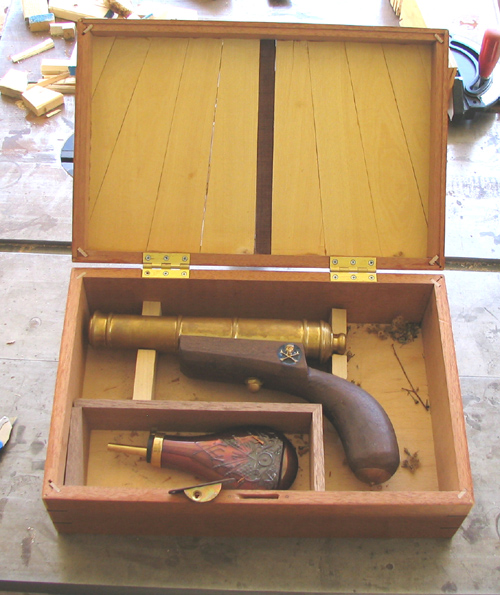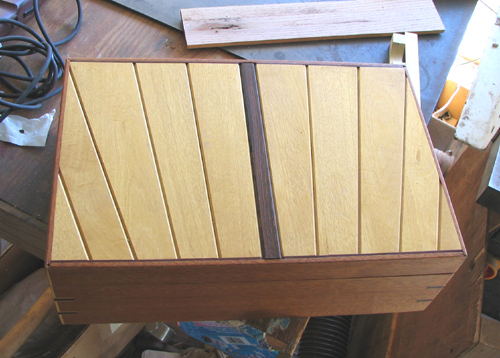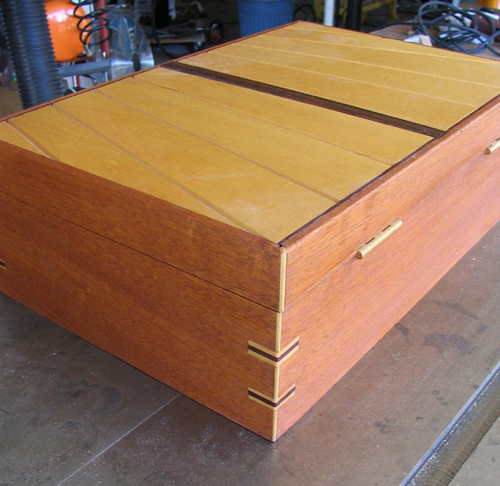March 1-31: Had to do a boring, repetitive production job to help pay the bills (Blue Cross raised our rates for a third time; now the nut is $1,800/month!!). Have been working on cannon, setting it to rights. Grief mostly behind me but Sandybear is still missed in the shop. Buddybear's staying pretty close these days and so is Shadow. Melanie roams as usual, none the worse for the change in lineup. Sigh...
Last year around this time I got to shoot my cannon for the first time and in so doing learned a lot about the proper kit one must have on hand. I've spent the past few weeks noodling on what's needed and making up a proper set of tackle so that I'd be ready in time for the next Big Event, which is scheduled for Saturday, April 5.
The first thing I needed to organize was a better method of aiming the beastie. Last year I missed the targets completely and managed to snap branches off of a nearby tree three times! I did quite a bit of searching around for what I wanted and failed completely, so I wound up making my own whatchacallit. It looks OK; the real test will be whether or not it works tho...
Dunno how it happened but, while making an extension to my honing tool, so's I could do a thorough cleaning job on my cannon's innards, I discovered that not one but two golf balls were stuck in the barrel; gremlins!! The first one came out with little effort but the last one was a real stinker. I wound up making a couple of tools to do the job; not so good for field work but adequate for use in the shop. What's needed in the field is a proper worm, but I've yet to find one made in the correct 1-11/16" diameter.
Somewhere in the midst of my follies I chanced upon plans for a "nano mortar" and I had to spend an hour or two making my own version. So far I've been unable to make it work worth a damn, but it looks cute. Hopefully I'll figure something out to improve its performance when I meet with the experts next weekend.
I plan on taking one other popgun to the cannon shoot. It's one of 40 replicas of the one used to start the bang-and-go-back steamboat race wherein Jessie James and the gang at Monster Garage challenged all comers. All the captains had a chance to buy one of these 'starting pistols' from the maker, who just happens to be hosting the cannon shoot. Long story short: Bruce is a fantastic machininst but the gun came in a packing crate that didn't do the thing justice. I spent a few months learning how to make boxes and this is the result.
| Photo #10: Here's the popgun in my partially-made display box. The gun lacks a trigger so it's technically a hand cannon, requiring a lit fuze to fire. Bore is .75 caliber, but the massive barrel makes the kick barely noticeable. In fact it's so heavy I intend to make a monopod to support it. I'm thinking it would be kewl to make something similar to what was used to support an arquebus. Have yet to figure out how to dress box lid on the inside; first I'm fitting the latch. |

|
| Photo #11: View of display box from above. Top is made from Yellowheart pieces, tapered and bevelled on their mating edges. Sides are made of Honduran Mahogany, with Purple Heart trim. Center post is Cocobolo. |

|
| Photo #12: Shot of corner detail. There's much I'd do differently if I ever get around to making another box. I've counted nine mistakes; an expert could probably find more. Still and all, to the casual observer it ain't too bad. Wouldn't give it as a gift, but it's plenty good enough for me. |

|
Return to Works In Progress